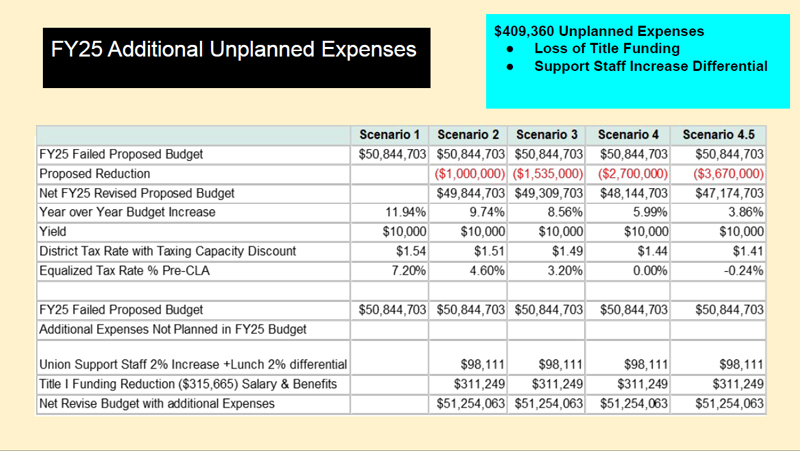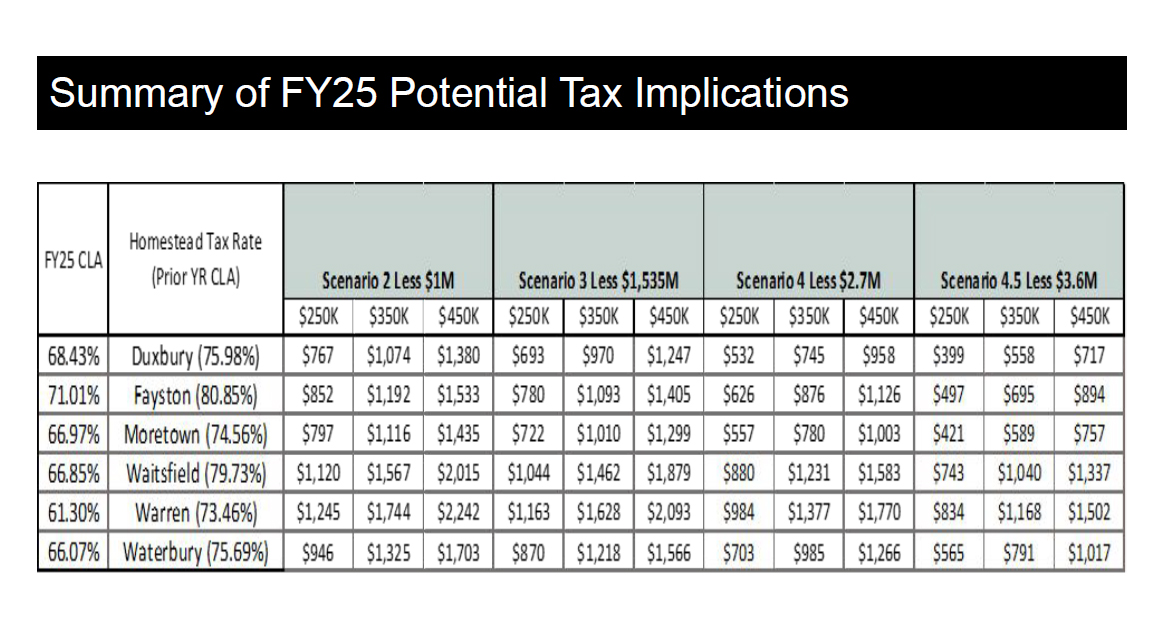Members of the Harwood Unified Union School District Board are in loose agreement about two different budget scenarios, one of which includes cutting no FTEs and one which includes cutting three FTEs.
Both scenarios include immediate savings on the $50.8 million budget that failed on Town Meeting Day by cutting a proposed $1 million contribution to the maintenance reserve fund. Both include cutting funding from other areas of school district operations.
At the March 13 meeting where the board considered those two scenarios – and several others – board members learned that the district would lose $311,249 in federal Title 1 funds and faced additional increases of $98,111 due to the newly signed support staff agreement – a total of $409,360.
District financial director Lisa Estler walked board members through several scenarios that cut $1million and up to $3.670 million -- before factoring in the $409,360. Factoring the $409,360 in, the scenarios would cut between $1,409,360 and $4,079,360.
The budget options are now based on an estimated equalized per pupil yield of $10,000. That number has been a moving target since late last fall, having ranged from $9,171 to this week’s $10,000. The higher the yield, the lower the final tax rate.
Estler explained the impacts of each of five scenarios, with the first one being the budget voters rejected at Town Meeting. That budget, using the new yield results in an increase in the pre-CLA tax rate of 7.20% over the prior year. The original budget carried a district tax rate of $1.54. Scenario 2 results in an equalized pre-CLA tax rate increase of 4.60% (and district tax rate of $1.51) and Scenario 3 reflects a 3.20% increase over the prior year (and a district tax rate of $1.49). The prior year’s tax rate was $1.44.
The way that Scenario 2 achieves savings by cutting $1,409, 360, including:
- Maintenance reserve $1 million.
- Operations and maintenance $257,800.
- District-wide technology $135,000.
- District-wide direct instructional supplies $16,560.
Scenario 3 achieves savings by cutting $1,944,360, including:
- Maintenance reserve $1 million.
- Operations and maintenance $297,800.
- District-wide technology $165,000.
- District-wide direct instructional supplies $73,000.
- District-wide professional development $35,000.
- Transportation (field trips/student interns) $43,000.
- Athletic equipment $18,500.
- 3FTEs (average $110,946) $312,060.
Scenario 2 results in a $49,844,703 budget and Scenario 3 results in a $49,309,703 budget.

Board members asked district superintendent Dr. Mike Leichliter about how staffing cuts would be made if they are made and whether people retiring or resigning could achieve those cuts. Leichliter said vacancy rates are not static and said that some vacancies must be filled to meet state and federal mandates.
“We lost a mental health clinician and we’re not filling that position. Anytime we have to do that it’s not like that person was sitting around not working. We have to determine what we can give up,” Leichliter said.
There was extensive discussion about whether district administration levels, with one principal per school, two at Brookside Primary, two at Crossett Brook and three at Harwood Union, were appropriate and whether or not the board should look to cut administrators before teachers.
Leichliter told the board that HUUSD student/principal ratios are in line with Vermont standards.
Warren board member Jonathan Young pushed back on the issue noting that the state’s 2017 guidelines for principals was a maximum of 306 students per principal.
“I’m not a fan of maxing out the ratio but I would prefer to go towards that max number for a short time verses impacting the student/teacher ratio. At Harwood there are 571 students and three administrators. To me that’s a slam dunk. We could lose one and still be under the ratio,” he said, noting that there are 272 students at Crossett Brook and cutting an admin there would still meet state standards,” Young suggested.
Young suggested that the Fayston and Warren Elementary Schools, with 89 and 108 students respectively could share an administrator for the combined 197 students and suggested the same for Moretown and Waitsfield where two administrators currently serve a total of 255 students.
“That would remove four principals at roughly $100,000 per position and we’d be staying below the max we see in the state,” Young said who pointed out that art and music and gym teachers are regularly shared by multiple schools and they move from school to school during the day.
Board members and Leichliter were not enthusiastic about those types of cuts to administrators. Board member Life LeGeros, Duxbury, said that he felt cutting administrators would negatively impact teachers. He said he is in the Waitsfield school often and can’t imagine the impact on that school of the principal spending half her time in Moretown.
Throughout this discussion and previous discussions, Estler has asked the board to identify a year-over-year target for spending as well as a pre-CLA tax rate. Estler also cautioned the board repeatedly that the proposed spending cuts are one-time cuts that are not sustainable.
Board chair Ashley Woods asked board members to weigh in on their sense of what their communities will support asking for; what they thought would pass on a second budget vote.
Board members also discussed asking voters to rescind a vote allocating $535,000 fund balance to the district’s maintenance reserve fund that was approved at Town Meeting. That would achieve a savings of $1,435,000 if the recission passed.
Woods said that moving the $535,000 to the district’s maintenance reserve fund was passed overwhelmingly by voters at Town Meeting and questioned whether the board should try to claw it back.

Moretown representative Steve Rosenberg said he felt the inclusion of a summary of post-CLA tax impacts on typical homes in each district town was an effective way to communicate with taxpayers.
Other community outreach suggestions included having board members attend select board hearings, inviting the public to come to the March 27 board meeting and using local newspapers and Front Porch Forum to explain the board’s position.













